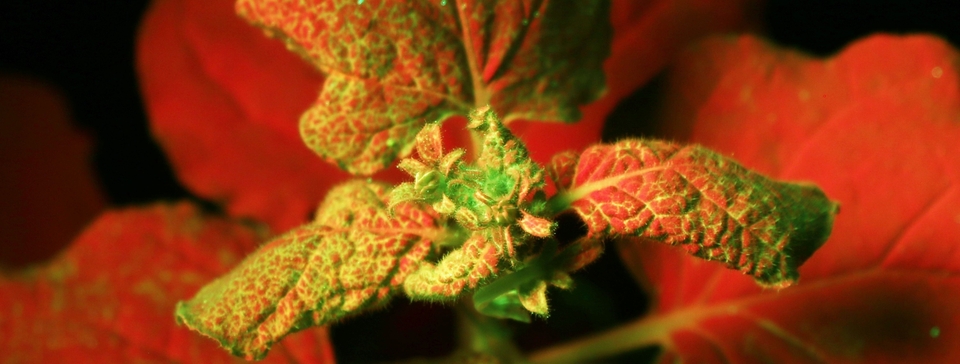PLoS Pathogens:浙大农学院李正和研究组发表植物负链RNA病毒反向遗
近期在微生物学权威期刊PLoS Pathogens在线发表浙江大学农业与生物技术学院植物病毒研究团队李正和研究员发表的一篇研究文章并得到该杂志网站在线重点推介,研究论文题为“Rescue of a Plant Negative-Strand RNA Virus from Cloned cDNA: Insights into Enveloped Plant Virus Movement and Morphogenesis”。农学院生物所博士生王强、硕士生马晓楠和博士生钱莎莎为该论文的共同第一作者,李正和教授为通讯作者,其它合作作者包括农学院周雪平教授以及美国加州大学伯克利分校Andrew Jackson教授等。
以病毒侵染性克隆为基础的反向遗传学技术体系是现代分子病毒学研究中最基本、最重要的技术手段。植物负链RNA病毒包括多种在作物生产上造成严重危害的病毒,如水稻条纹病毒是我国水稻上的重要病害之一,番茄斑萎病毒在世界范围内引起多种作物的毁灭性病害。然而,由于技术上的困难,20多年以来,国际上一直未能突破植物负链RNA病毒的侵染性克隆技术,反向遗传学技术体系的缺失严重限制了这类病毒的分子生物学研究。
课题组以植物负链弹状病毒(Rhabdovirus)——苦苣菜黄网病毒为模式,历经数年的努力,成功解决了制约植物负链RNA病毒研究的技术难题,实现了病毒全长cDNA侵染性克隆技术的突破,获得了与野生型病毒具有同等侵染活性的重组病毒。在此基础上,本研究还发现,该病毒基因组内可插入外源基因片段,且在插入片段的稳定性和包容性方面较其他类型的植物病毒具有明显的优势,适合于作为病毒载体表达外源基因。此外,本研究利用反向遗传学方法进一步解析了包膜病毒胞间运动、系统运动和粒子形态建成等过程,为该类病毒的生物学提供了新的见解,并为其它相关病毒的反向遗传学研究提供了可供借鉴的模版。
研究工作投稿后得到了3位匿名评审专家一致的高度评价,认为本研究“有望革命性地改变植物负链RNA病毒生物学(expected to revolutionize plant NSR virus biology in future)”。

原文链接:
Rescue of a plant Negative-Strand RNA Virus from Cloned cDNA: Insights into Enveloped Plant Virus Movement and Morphogenesis
原文摘要:
Reverse genetics systems have been established for all major groups of plant DNA and positive-strand RNA viruses, and our understanding of their infection cycles and pathogenesis has benefitted enormously from use of these approaches. However, technical difficulties have heretofore hampered applications of reverse genetics to plant negative-strand RNA (NSR) viruses. Here, we report recovery of infectious virus from cloned cDNAs of a model plant NSR, Sonchus yellow net rhabdovirus (SYNV). The procedure involves Agrobacterium-mediated transcription of full-length SYNV antigenomic RNA and co-expression of the nucleoprotein (N), phosphoprotein (P), large polymerase core proteins and viral suppressors of RNA silencing inNicotiana benthamiana plants. Optimization of core protein expression resulted in up to 26% recombinant SYNV (rSYNV) infections of agroinfiltrated plants. A reporter virus, rSYNV-GFP, engineered by inserting a green fluorescence protein (GFP) gene between the N and P genes was able to express GFP during systemic infections and after repeated plant-to-plant mechanical passages. Deletion analyses with rSYNV-GFP demonstrated that SYNV cell-to-cell movement requires the sc4 protein and suggested that uncoiled nucleocapsids are infectious movement entities. Deletion analyses also showed that the glycoprotein is not required for systemic infection, although the glycoprotein mutant was defective in virion morphogenesis. Taken together, we have developed a robust reverse genetics system for SYNV that provides key insights into morphogenesis and movement of an enveloped plant virus. Our study also provides a template for developing analogous systems for reverse genetic analysis of other plant NSR viruses.
DOI: 10.1371/journal.ppat.1005223
作者:李正和

